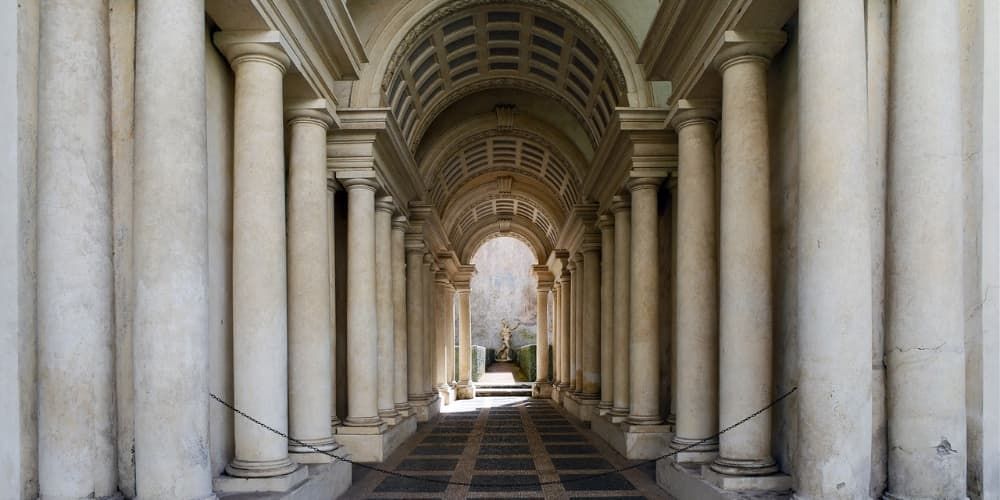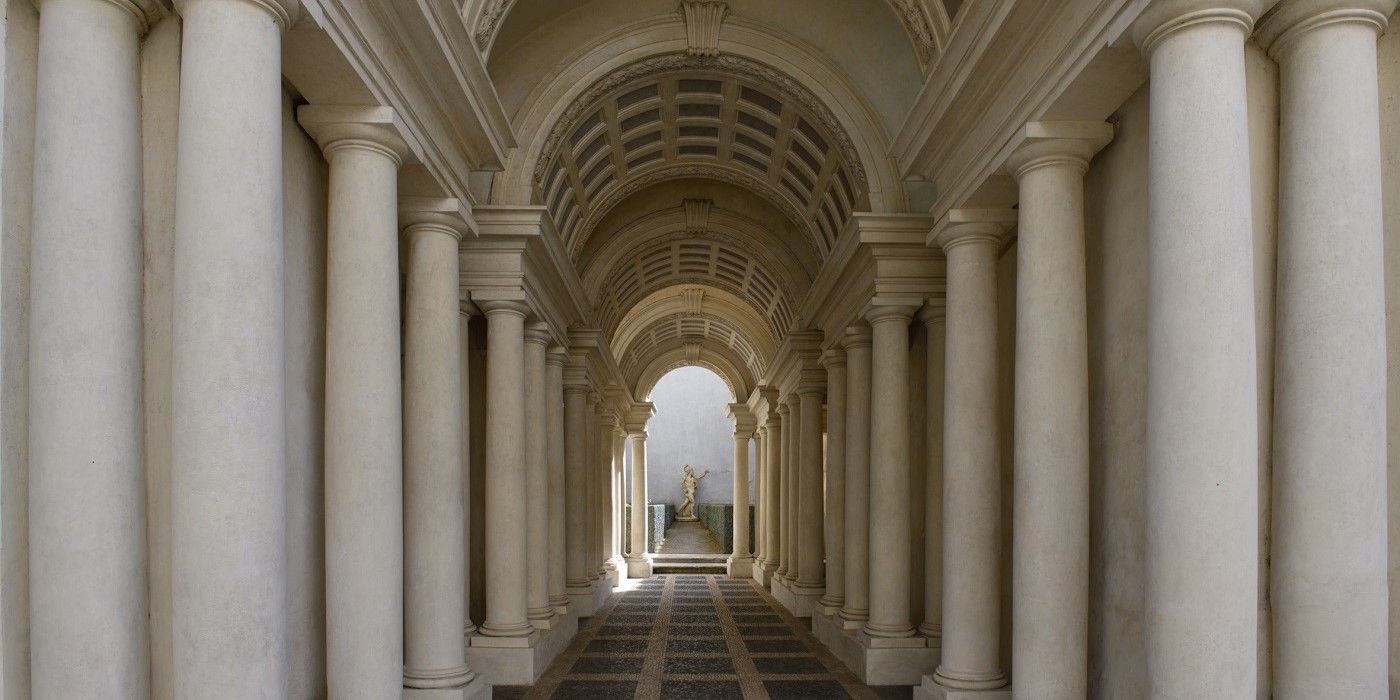Among the blowing optical illusions scattered throughout Italy, there is one waiting to be discovered: the colonnade of the Galleria Spada in Rome. Famous as Borromini's accelerated perspective, this fascinating visual trick is hidden in a corner of the secret garden of Palazzo Spada, a historic building located in Piazza Capo di Ferro, a small square in the heart of the capital along the route from Piazza Farnese to Via Arenula.
Over the years, the optical illusion created by Francesco Borromini has captivated thousands of visitors, drawn to this masterpiece of visual engineering, which is one of the finest examples of Baroque perspective illusionism. The beauty of the portico is even more striking because it appears at the end of the visiting tour: it is the icing on the cake of an immersive adventure that arouses amazement and wonder thanks to a surprising three-dimensional effect.

Baroque art and magnificent tricks: Galleria Spada in Rome

Palazzo Spada enchants the eye of the beholder with its elegant facade, rich in splendid stucco decorations. On the first floor, you can admire the niches with statues of illustrious men of Rome: Trajan, Pompey, Fabius Maximus, Romulus, Numa Pompilius, Marcus Claudius Marcellus, Julius Caesar, and Augustus. In the center stands the Spada coat of arms, surrounded by medallions bearing the emblem of Cardinal Girolamo. On the top floor, the panels recount the exploits of the eight illustrious men, alternating with the windows.
The spirit of 17th-century Italy can be felt in the internal courtyard with its porticoes and, above all, in the Baroque picture gallery, which houses artistic and archaeological works collected in the first half of the century by Cardinal Bernardino Spada and then by his great-grandson Fabrizio. The collection has been expanded over the years by the contributions of two women: Maria Veralli, the wife of Orazio Spada, and Maria Pulcheria Rocci, the wife of Prince Clemente. What makes the visit truly special is its conclusion: the passage through Borromini's gallery, which perfects anamorphosis (the perspective technique of image distortion) with astonishing geometric precision.
Visit Rome with Visit Rome PassThe history of Palazzo Spada
Inaugurated in 1540, Palazzo Spada currently houses the Italian Council of State and became iconic due to the movie The Great Beauty directed by Paolo Sorrentino. It owes its name to Cardinal Bernardino Spada, an archbishop and art collector from Emilia who arrived in Rome in 1631 to hold important positions in the Curia. In 1632, the cardinal purchased the then Palazzo Capodiferro, one of the most beautiful Renaissance buildings in the city, built during the pontificate of Julius III, for 32,000 scudi. The cardinal immediately began collecting paintings by artists of the caliber of Titian, Guercino, Jan Brueghel the Elder, Bernini, Guido Reni, and Artemisia Gentileschi, while at the same time commissioning Francesco Borromini to carry out extension work on the palace.
Originally from what is now Canton Ticino but working almost exclusively in Rome from 1619 onwards, Borromini is one of the most important exponents of Baroque architecture: his signature can be seen on the church of San Carlo alle Quattro Fontane, Palazzo Falconieri in Via Giulia, the church of Sant'Ivo alla Sapienza, the Oratory of the Filippini, the church of Sant'Agnese in Agone in Piazza Navona, the church of Santa Maria dei Sette Dolori on the slopes of the Janiculum Hill, and the façade and internal chapel of the Palazzo di Propaganda Fide in Piazza di Spagna. When Cardinal Spada summoned him to Palazzo Capodiferro, Borromini had the idea of modifying the facade according to the tastes of the time, of building the long wing that runs along the Regola district and, above all, of creating what became the famous perspective gallery.
Borromini's optical illusion
Borromini's perspective is one of the most incredible optical illusions that can be admired in Rome. Commissioned by Cardinal Spada in 1653, the colonnade is located in the building's secret garden and continues to amaze visitors almost four hundred years later. Thanks to the mathematical calculations of the Augustinian priest Giovanni Maria da Bitonto, a religious man, scientist, painter, friend, and collaborator of Borromini, the Ticino architect manages to leave visitors to this particular corner of Palazzo Spada speechless with a special effect that is as simple as it is effective.
Originally, the gallery ended with a wall painted to simulate the effect of a forest: guests were thus given the illusion that beyond the vaults and columns there was a real garden. It was only in the mid-19th century that Prince Clemente Spada had the small statue of a warrior added to the end of the colonnade, which can be admired today. The cardinal's heir was a lover of art, theater, and dramatic effects – he had the idea of placing a statuette at the end that appears life-size thanks to the perspective effect, but which is actually just less than 20in tall. If this result works and amazes, it is thanks to Borromini's work on perspective.
Looking at the gallery from the outside (you cannot walk inside it in order to preserve the mosaic floor), it appears much longer than it actually is: the 315-in-long corridor seems to be more than 1,181in long. The effect is created by some ingenious architectural features: the convergence of the floors at a single vanishing point, with the statue at the end of the courtyard accentuating the illusion of depth; the slightly sloping floor; the ceiling that slopes downwards. The philosophical meaning is a warning to those who arrive and observe declive – we must go beyond appearances to discover the true essence of what surrounds us.
Discover the collection highlights
In addition to the architectural illusionism that makes a portico just over 315-in-long appear as a 1,181in colonnaded corridor, Galleria Spada stands out for its collection of paintings, marble sculptures, and antique objects displayed in the building's four rooms. There are many works preserved in the museum: among the most important are Guercino's Death of Dido, Guido Reni's Saint Jerome, Titian's Portrait of a Musician, Jan Brueghel the Elder's Landscape with Windmills, and Artemisia Gentileschi's Madonna and Child and Saint Cecilia.
No less impressive are Amico Aspertini's Saint Christopher, Gian Lorenzo Bernini's Bust of Laocoon, the Three Heads attributed to the school of Parmigianino, Annibale Carracci's Portrait of a Young Man, Domenichino's Portrait of a Man, Pietro Testa's Sacrifice of Iphigenia, and Salvator Rosa's Seascape. But the four rooms contain more than just paintings and sculptures, some of which date back to Roman times: the ceilings feature splendid decorations and among the various objects housed in the palace are the famous globes by Willem Blaeu, official cartographer of the Dutch East India Company.
Visiting info: hours and tickets
You can visit the permanent collection of the Galleria Spada, including Borromini's perspective, every day from Monday to Sunday, except Tuesdays. Opening hours are from 8:30 a.m. to 7:30 p.m., with last admission at 7 p.m. The exact address is Piazza Capo di Ferro 13, and the entrance is opposite Palazzo Spada. The gallery is easily accessible on foot from Campo de' Fiori, by bus from Termini with lines 64 and 70, or by buses 492 and 81. No reservation is required: reservations are only necessary for group visits, i.e., for more than six people. Photographs may be taken of the works and the gallery, but not with tripods and easels unless authorized by the management.
Tickets to visit the Galleria Spada are available on the Italian Museums portal and are very affordable: €6 for adults and €2 for concessions, which are available to holders of the Italian Youth Culture Card and Merit Card and to European Union citizens aged between 18 and 25. Admission is free for children under 18, people with disabilities, and those entitled to concessions. On the first Sunday of the month, admission is free for everyone. During your visit, the management recommends that you always follow the notices and advice of the staff to avoid crowding in the museum rooms. If you would like to book a guided tour, you have to contact the Artem agency.
What is special about Galleria Spada in Rome?
It is located in the heart of the city in a historic building such as Palazzo Spada (formerly Palazzo Capodiferro) with a facade rich in Mannerist stucco decorations that leave you speechless. It has an impressive collection of Baroque paintings and sculptures from the 16th and 17th centuries, a charming courtyard with porticoes and, above all, the entrance hall to the courtyard, which houses the trompe-l'oeil masterpiece of false perspective known as Borromini's perspective.
How does Borromini's perspective work?
The architect arranged arches and side columns that gradually decrease in size, adding a series of features such as an upward-sloping floor, a downward-sloping ceiling, and a small statue at the end of the courtyard (less than 20in tall, despite appearing life-size) as a vanishing point to accentuate the illusion of depth. It is thanks to this sophisticated system that the corridor, only 315-in-long, appears to be more than 1,181in long. Borromini's goal was to warn of the illusory nature of earthly life.
Is Galleria Spada worth visiting?
Yes, Galleria Spada is definitely worth a visit, both for the works of art preserved in its four rooms (created by artists such as Titian, Guido Reni, Jan Brueghel the Elder, Guercino, Hans Dürer, Domenichino, Annibale Carracci, Salvator Rosa, Andrea del Sarto, Amico Aspertini, Francesco Solimena, and Artemisia Gentileschi) and for Borromini's incredible colonnade, which tricks the eye and plays with the viewer's perception. The standard entrance fee is €6.
About the author
Written on 09/10/2025





Alessandro Zoppo
Discover the magic of Galleria Spada in Rome: its garden hosts a colonnade that tricks the eye, which has become famous as Borromini's perspective.